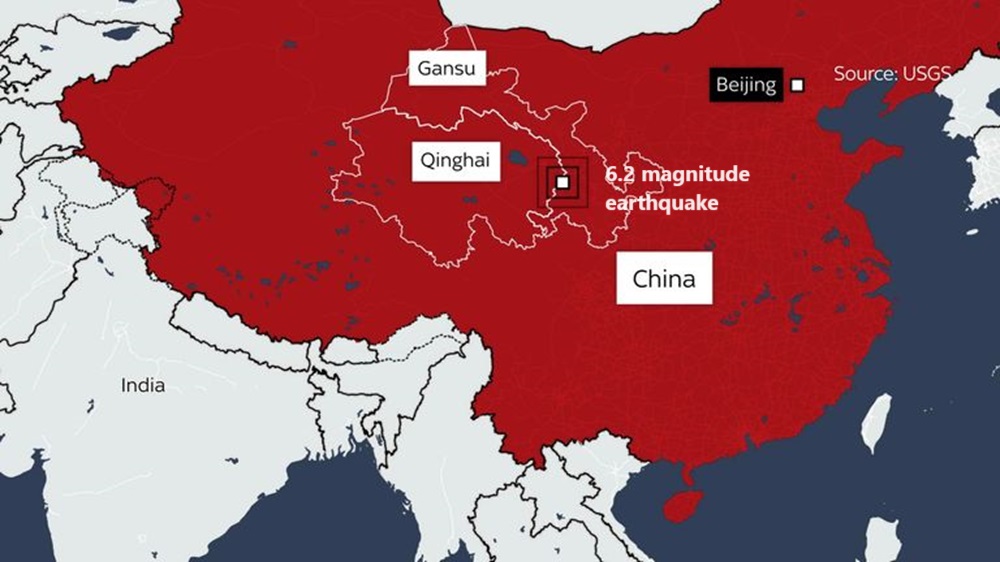At least 127 people have died in the country’s deadliest earthquake in years, which struck north-west China. The 6.2 magnitude earthquake struck mountainous Gansu province at midnight (16:00 GMT) on Monday, shaking neighboring Qinghai.
With over 700 people hurt in treacherous conditions, the death toll could grow. Chinese President Xi Jinping has dispatched thousands of rescue personnel to the province, which is among China’s poorest and most diverse.
The earthquake is the country’s deadliest since a tremor in south-western Yunnan province killed over 600 people in 2014.
On Tuesday, video shown on state television and other media networks showed entire villages shattered by the earthquake, as well as crumbled buildings and houses.
Residents who had evacuated their homes were also seen huddling around improvised fires in hastily constructed evacuation camps. Temperatures reached -13C (8.7F) on Tuesday, according to the BBC.
Survivors described the shocks as “being tossed by surging waves” and described fleeing their apartments.
Local officials in Jishishan county, Gansu province’s worst-affected district, reported more than 5,000 buildings had been damaged. Many additional structures in the province have been damaged by mudslides caused by the earthquake, and dozens of highways have been affected.
According to Chinese media, a director of the Gansu rescue team blamed the widespread damage on poor building quality in the communities, with many dwellings being old and composed of clay.
Gansu borders Mongolia and is located between the Tibetan and Loess plateaus. The rural area is one of the poorest and most ethnically diverse in China. The epicenter of the earthquake was in Linxia Hui Autonomous Prefecture, which is home to various Chinese Muslim groups including as the Hui, Bonan, Dongxiang, and Salar.
The quake reached 6.2 on the Richter scale, according to Chinese authorities, while the US Geological Survey (USGS) estimated a magnitude of 5.9 and a depth of 10km (6 miles). According to local authorities, about ten aftershocks have occurred.
A 5.5 magnitude earthquake struck Xinjiang, a region west of Gansu, on Tuesday, but there were no early reports of injuries.
Power and water supplies have been affected throughout the region, hampering rescue attempts. Officials said they only have a limited amount of time to save people in the subzero temperatures.
“It is too cold to bear… it’s -15C [here],” Wang Yi, chief commander of the Blue Sky Rescue Team, told the BBC. With over 30,000 volunteers around the country, Blue Sky is China’s largest non-governmental humanitarian organization.
Mr Wang predicted that the number of casualties would rise. “We must now dig deeper [into the rubble].” However, there are no large structures in the region. So it will climb, but not significantly,” he said.
According to President Xi, “all efforts should be made to carry out search and rescue, treat the injured in a timely manner, and minimise casualties” .
Earthquakes in China
China is located in an area where several tectonic plates converge, most notably the Eurasian, Indian, and Pacific plates. It is very vulnerable to earthquakes. In 2010, an earthquake in Yushu, Qinghai province, near Gansu, killed about 2,700 people.
The most severe earthquake in recent Chinese history struck the south-western province of Sichuan in 2008, killing 87,000 people.
Earthquakes are widespread in China, which is a seismically active country. Because of the intricate interactions of numerous tectonic plates, including the Eurasian Plate, Pacific Plate, Indian Plate, and Philippine Sea Plate, the country is located in a seismically active zone.
Throughout history, China has seen several noteworthy earthquakes. The Tangshan earthquake of 1976 was one of the deadliest in recorded history, resulting in substantial loss of life and property. Recently, the Sichuan earthquake rocked the Wenchuan region in 2008, causing massive devastation and a large number of casualties.
To lessen the impact of earthquakes, China has substantially invested in seismic monitoring, early warning systems, and infrastructure. The China Earthquake Administration (CEA) is in charge of tracking and researching seismic activity in the country. They work to improve earthquake response, preparedness, and public awareness.
It’s crucial to remember that seismic activity involves unpredictability, and earthquakes can happen at any time. Scientists continue to study and monitor seismic activity in order to better understand earthquake patterns and improve preparedness and response methods.






